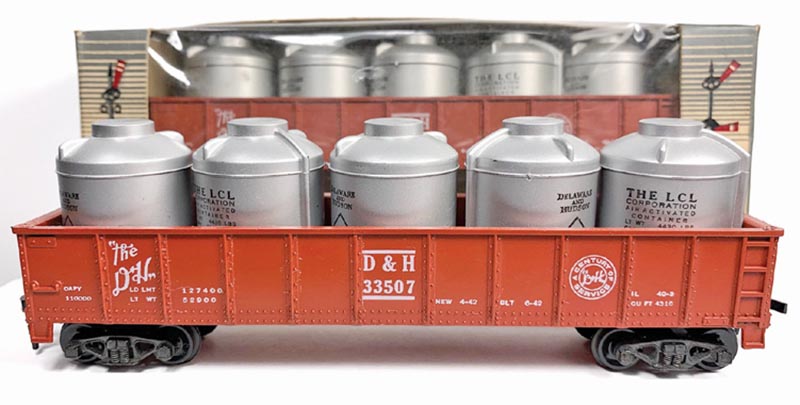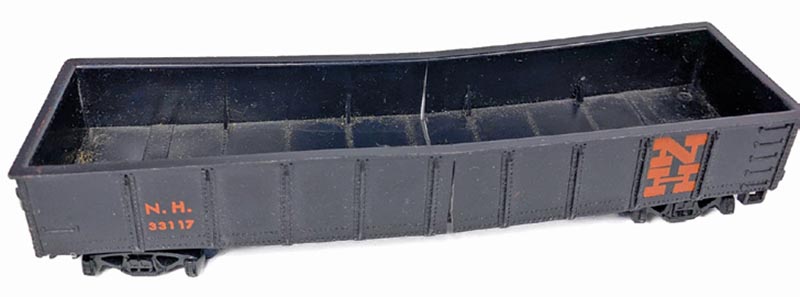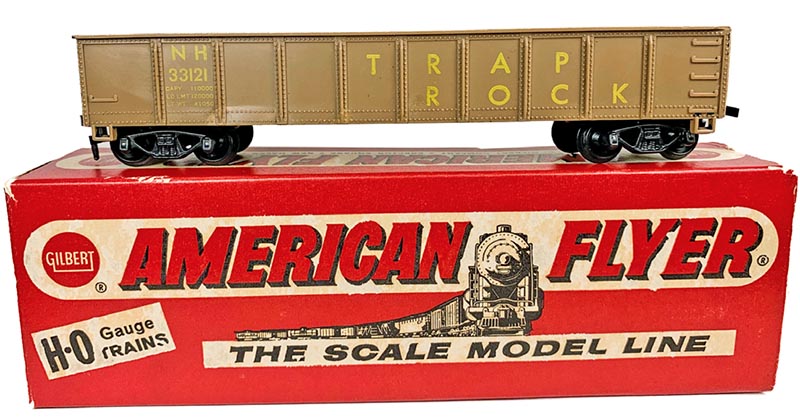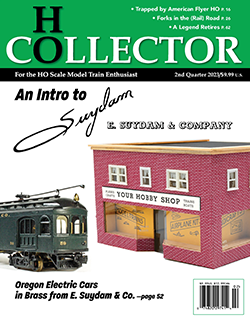If you had to pick just one freight car (or locomotive) that you felt best described a particular manufacturer’s entire train lineup, could you do it? I would venture to say that if we had 50 Gilbert HO collectors in one room pick out the one car that best represented the American Flyer HO line overall, we would end up with 50 different pieces being chosen. Gilbert offered approximately 225 different cars and locomotives across its 25-year span in the HO market. Please bear with me here as I present the unusual car that I feel best represents Gilbert’s HO lineup that started in 1938 and ended in 1963.
Manufacturers produce many different types of models over the years they are in business, and Gilbert was no exception. Of course, those cars are given various paint schemes, and at times, small changes are made to enhance or alter their appearance. Case in point is the Gilbert HO American Flyer Tie Car (33820). This car, made from 1961 through 1963, originated with a mechanism installed that when activated by a track trip ejected a plastic railroad tie. It was a very tinplate-like car and the tie-ejecting mechanism enhanced the toy-like appearance of it.
Perhaps in an effort to save money, or in an attempt to make it more “scale like,” Gilbert began offering a version of this car in 1963 with the tie-ejector mechanism removed and the car was relettered as its Erie Work Caboose (33626). The colors of the car remained the same. The former car release is fairly common, but Gilbert’s Erie Work Caboose tends to be harder to find as they were made near the end of HO production and only offered in one boxed set. The popularity of Gilbert’s HO line overall had shrunk substantially, and sales were poor by the early 1960s.

ABOVE: Gilbert’s Delaware & Hudson (33507) is only known to have been offered to the public in a non-weighted version, and came with five (and sometimes only three) silver plastic canisters for a load.
Even though American Flyer’s Tie Car actually shows the company brand “American Flyer” on its sides (the only Gilbert HO car that does), that model does not “speak” for the entire HO line like the line’s New Haven Trap Rock gondola (33121) produced during Gilbert’s “Pike Master” era.
What does the Pike Master name allude to? It was a name adopted by Gilbert in 1961 for both its HO (1:87) and S (1:64) train lines. The Pike Master name continued to be used until the end of train production which was 1963 for HO and 1966 for S gauge. The name suggests that the proud owner of an American Flyer train was the Yard Boss of his layout (aka the Pike Master), and his trains were the very best. But that was a very far-reaching term, as trains (HO and S) made under the Pike Master banner were very cheaply made and unrealistic toys versus being authentic scale replicas. The general public had little interest in owning these sets, especially HO modelers who were typically aiming toward realism on their layouts.

ABOVE: Scarce Gilbert HO Bethlehem Steel (33116) weighted-version gondola. Note cracking in car side (impacting the car’s second rib from the left and third panel along the lower area near the frame). The rail load (Gilbert’s S-gauge rails) is often missing when this model appears today. This example is also missing both stirrup steps on this side.
Pike Master cars and locomotives (especially diesel locomotives) were subjected to downgrades in quality and detail in order to produce these items at lower cost. For example, brake wheels, which were formerly a separate add-on piece, were now integrated into the plastic bodies on stock cars, gondolas, cabooses, and hopper cars. Also, these offerings (and other cars that were not downgraded quite so extensively) were now being made with cheaper, reduced quality plastic trucks that were all one piece (including the simulated springs) and the wheels were oversized and very toylike.
These changes caused Gilbert’s HO line to strongly resemble the Marx HO line of trains; those later-era trucks were used by both Gilbert and Marx. Today, many uneducated collectors frequently confuse the two lines as their appearance is that similar.

ABOVE: The black with orange/red lettering New Haven gondola (33117) shows off a common and unfortunate issue with these Gilbert offerings… the plastic body is cracked nearly into two pieces down its center. The model remains together thanks to its weight (below the floor of the gondola), though this is also the culprit that caused the problem.
The inclusion of Pike Master “operating cars” really fed fuel to the crashing and burning train line. Very toylike cars such as a TNT or Mine Exploding boxcar were reminders of the war-themed mindset; and an operating Rocket Launcher and Nike missile car seemed to be late additions to the quickly passing “space race” fad of toy trains.
Pike Master’s stock cars with ejector mechanisms that shot out a small plastic “hay bale” from the open door of the model did nothing for modelers seeking prototypical appearance and operation. And, like the aforementioned Tie Car, in later production these releases lost their hay-ejector mechanisms and were offered without this feature. (These cars produced without their ejector mechanisms are now scarce, high-priced collector items.) Unsold Pike Master sets piled up in warehouses and the writing was on the wall with regard to train sales at Gilbert. On the other hand, slot car sales were taking off and Gilbert turned its attention to this moneymaker as time was running out on the train line…




